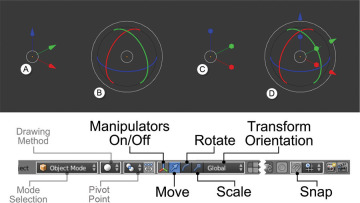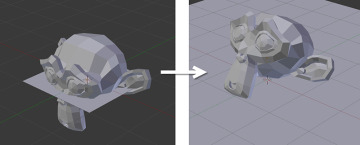Blender Rotate Object 90 Degrees
This chapter is from the book
Moving, Rotating, and Scaling
After you create objects in your 3D scene, you need to be able to control where they are located, how they are oriented, and what size they are. In this section, you see how to do just that. Moving, rotating, and scaling are the three different transform operations you can perform on an object.
Using Manipulators (Basic Mode)
When you want to transform objects or elements in the 3D scene, Blender offers manipulators that help you control those transformations. Following are the different manipulators (see Figure 3.1):
-
Move (A): Changes the position of an object in space
-
Rotate (B): Controls the orientation of an object
-
Scale (C): Manipulates the size of an object
-
All Transforms (D): Provides the option to use more than one transform manipulator at the same time

Figure 3.1 Manipulators in Blender and the transform controls in the 3D View header
In the 3D view header, you can select the type of transform you want to perform. If you press Shift while clicking different transform icons, you can perform multiple transforms at the same time. (In Figure 3.1, example D shows all three transform manipulators being used at the same time.)
Using the different manipulators, you can move, rotate, and scale objects. These manipulators appear at the pivot point of the object (marked as a little orange spot, called "origin" in Blender), and you perform an action with them by using the following controls:
-
Left-click one of the axes to make the object move, rotate, or resize on that specific axis. (X is red, Y is green, and Z is blue.) Left-click again to confirm the transform. Or press Enter to confirm or Esc to cancel.
-
To enable precision mode, press and hold Shift after you click to transform. This action makes the transform slower, allowing you to make precise adjustments.
-
To lock one axis and manipulate the other two, press and hold Shift before you click the axis you want to lock. If you press Shift and then click the Z-axis to move it, for example, the object actually moves on the X- and Y-axes, as the Z-axis is locked. (This option works only for moving and scaling; it is not available for rotations.)
-
Each manipulator has a small white circle in its center. Click and drag that circle with the Move manipulator to move the object using the current point of view as a reference (dragging it parallel to the view). Click and drag the small white circle within the Rotation manipulator to enter orbit mode, which allows you to rotate on all axes at the same time. Click and drag the small white circle of the Scale manipulator to scale the object on every axis. The Rotation manipulator also has an outer white circle; click and drag that circle to rotate the object using the current point of view as the rotation axis.
-
Hold down Ctrl while using these manipulators to switch between normal transforms and snap mode. This feature allows you to snap to several elements while you perform transforms. If snapping is enabled, holding down Ctrl frees the object when transforming; if it's disabled, holding down Ctrl enables the snapping. This feature is very useful because you won't need to continuously turn the Snap tool on and off by clicking the Snap icon on the 3D View header.
-
In the 3D view header, you can select Pivot Point and Transform Orientation. The pivot point defines the point around which objects rotate and scale. By default, Transform Orientation (access this menu by pressing Alt+Space) is global, which means that it's aligned to the 3D World axes (default scene axes: X is left/right, Y is front/back, and Z is top/bottom). You can switch the Transform Orientation to the local axes of the selection to transform objects using their own orientation.
Using Keyboard Shortcuts (Advanced Mode)
Although you can use manipulators easily, the expert, really fast way to transform objects in Blender is to use keyboard shortcuts. Sometimes, the manipulators are useful, but most of the time and especially for simple transforms, using the keyboard is faster and more efficient. Here are some of the most relevant keyboard shortcuts that make transforms easier and faster:
-
Press Ctrl+Space to show or hide the manipulators (or click the Manipulator On/Off icon on the 3D view header).
-
Press G (Grab) to move, R to rotate, and S to scale. When you do these things to move and rotate the objects, they move and rotate according to the view. Left-click to confirm, and right-click or press Esc to cancel.
-
After pressing G, R, or S, if you press X, Y, or Z, the selection transforms only on that global axis. Press X, Y, or Z twice to align to the selection's local axis.
-
Press R twice to enter trackball rotation mode, which makes the object rotate in all axes following your mouse movements.
-
As an alternative to the previous option, when you're transforming with no attachment to a given axis, you can press MMB. Lines for the axes appear, and if you move the object close to one of those lines, it is automatically locked to that specific axis.
-
Precise transforms, snapping, and axis locking using Shift and Ctrl while transforming with manipulators also apply when you use keyboard shortcuts. Press G and then Shift+Z to translate the object in the X and Y axes at the same time, for example.
Arranging Objects in Your Scene
Now that you know how to transform objects, you can make your floor bigger and sit the monkey head on it (see Figure 3.2), as follows:
-
Right-click to select the plane, press S to scale, enter 5 from your keyboard to make the plane 5 times bigger, and press Enter to confirm. (Or use the manipulators if you feel more comfortable with them.)
-
Select the monkey head, moving and rotating it until it looks as though it's sitting on the floor. As a recommendation, you can switch the 3D View to a side view to see what's going on more clearly and transform the head there by using G and R. Keep in mind that if you're in a side view and rotate using R, the object will rotate on the X-axis.

Figure 3.2 The scene before and after the transforms
Blender Rotate Object 90 Degrees
Source: https://www.informit.com/articles/article.aspx?p=2783635&seqNum=2#:~:text=Press%20R%20to%20rotate%2C%20press,degrees%20on%20the%20Y%2Daxis.
Posted by: evansclaidecon.blogspot.com

0 Response to "Blender Rotate Object 90 Degrees"
Post a Comment